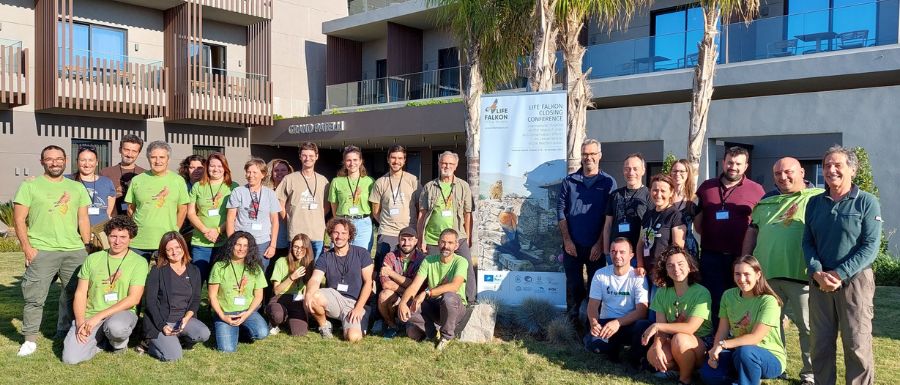The LIFE FALKON Final Conference was conducted in Myrina, Lemnos Island, Greece, spanning from the 12th to the 14th of october. As one of the partners, ALDA participated in the event alongside CNR, ISPRA, UNIVERSITY OF MILAN, and HOS.
The inaugural day of the conference commenced with a presentation of Lemnos Island as one of the project’s focal areas, where the Lesser Kestrel migrates during the spring and summer months. The selection of this island was deliberate, considering its agricultural landscape and its substantial cultural and ecological value.
Following this introduction, the LIFE FALKON consortium provided a comprehensive overview of the project, beginning with its background and objectives. They then delved into topics encompassing genomics, population movements across the globe, and the conservation efforts integral to the project. The day concluded with insights into outreach activities targeting students, citizens, stakeholders, and communication initiatives. During the afternoon, a diverse group of researchers and experts had the opportunity to present their work. The first lectio magistralis was delivered by Ms. Ines Catry, a researcher at BIOPOLIS-CIBIO, who has dedicated 24 years to monitoring the Lesser Kestrel population in Portugal. Her research investigates the impact of agricultural practices and climate change on the species, as well as the effectiveness of conservation measures aimed at halting population declines.
This underscored the necessity for evidence-based conservation to ensure the long-term survival of the Lesser Kestrel. Subsequently, various researchers shared their findings, addressing a range of topics. These included the comparison of traditional and modern buildings for Kestrel falcon conservation, spanning over 30 years of study and experience (Mr. Pepe Antolin of DEMA), efforts to strengthen and stabilize the Lesser Kestrel population in northern Greece and Bulgaria (Mr. Kostas Vlachopulos of Πανεπιστήμιο Θεσσαλίας), and the occupancy rates of artificial nest boxes by Lesser Kestrels in the Sakar SPA, as well as the combined structure for ex-situ breeding, adaptation, and release of Lesser Kestrels in the wildlife rehabilitation and breeding centre of Green Balkans (Ms. Iiyana Yaneva and Ms. Yordanka Vasileva, Green Balkans NGO).
The second day of the final conference was equally engaging, featuring a multitude of experts who shared their research insights. The morning began with the second lectio magistralis, presented by Mr. Javier Bustamante of CSIC, a seasoned researcher and specialist in Lesser Kestrels in southern Spain since 1990. He discussed his intriguing study on the movement patterns of these birds. Subsequently, other experts discussed their research findings, including Ms. Gaia Bazzi from ISPRA, who outlined the significant population decline and range contraction of the lesser kestrel over the last century, attributing it to sahelian rainfall and intensified agriculture in breeding areas.
Further presentations covered a wide array of subjects, including the potential threats of onshore wind power to the Lesser Kestrel on an intercontinental scale, the impact of rising temperatures on reproduction, the long-term persistence of this bird in Sicily (Italy), non-breeding movement patterns, and more.
Subsequently, a comprehensive array of research topics were presented:
- An intercontinental-scale assessment of the potential threats posed by onshore wind power to the Lesser Kestrel. Notably, 30% of European breeding colonies are located within 10 km of a wind turbine, with the Italian population facing the highest exposure (presented by Mr. Giacomo Assandri, University of Turin).
- The impact of rising temperatures on reproduction in the Lesser Kestrel. High nest temperatures were found to have profound effects on hatching failure, nestling survival, and even influence nestling and adult behavior (presented by Mr. Alejandro Corregidor-Castro, CNR/University of Padua).
- A study on the long-term persistence of the Lesser Kestrel in Sicily (Italy)over the past 24 years (presented by Mr. Maurizio Sarà, University of Palermo).
- Insights into the non-breeding movement patterns of the Lesser Kestrel (presented by Mr. Samuele Ramellini, University of Milan).
- An introduction to a project focused on the habitat selection of Italian Lesser Kestrels in the pre-breeding period (presented by Ms. Anna Kyriakopoulou, Aristotle University of Thessaloniki).
- An examination of the population of Lesser Kestrels present in Albania prior to their migratory movements. (Presented by Ms. Klea Duro, AOS-Albanian Ornithological Society)
- An exploration of the benefits of providing artificial nests in Portugal, considering both the costs and the impact on the Lesser Kestrel population. (Presented by Mr. João Gameiro, BIOPOLIS-CIBIO)
- A study of the phenomena characterising the Po Plain, where three species of falcons share similar habitats and diets. (Presented by Mr. Alessandro Berlusconi from the University of Insubria)
- An examination of the feeding ecology and conservation efforts for the Lesser Kestrel in intensive agricultural landscapes in Italy. (Presented by Ms. Claudia De Battisti, University of Padua)
- A fascinating account of the journey of Ema, a female lesser kestrel equipped with the Microwave Argos tag, as she visited 18 different countries over a span of 5 years. (Presented by Ms. Svetla Dalakchieva, Green Balkans)
- The revelation of the first breeding record of the lesser kestrel in Bosnia-Herzegovina. (Presented by Ms. Biljana Rancobic and Mr. Goran Topic)
The day concluded with Mr. Michelangelo Morganti, the coordinator of the LIFE FALKON project, and Mr. Javier Bustamante sharing their experiences in Senegal, where they followed and studied the lesser kestrel in November 2022.
The final day began with an excursion to the island of Limnos, specifically the ‘Romanos’ village, an intervention site of LIFE FALKON and one of the largest Lesser Kestrel colonies on the island. The group also explored the Keros – Alyki area (Greece) on the east coast of Lemnos, a part of the Nature 2000 SPA area. The excursion concluded with a shared meal at the MANTRA TIS ATHINAS farm, where attendees savored local dishes and observed various bird species present on the island, thanks to the favourable weather.
